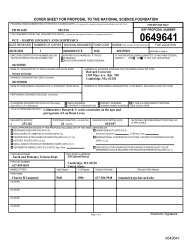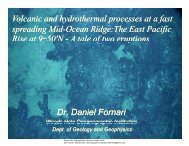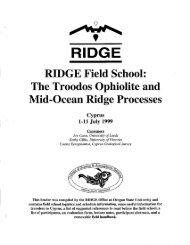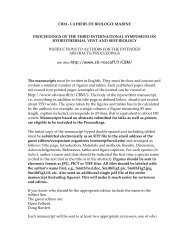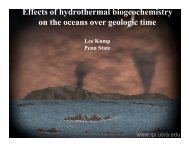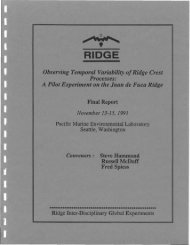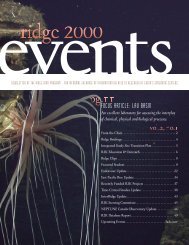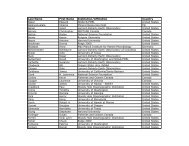Create successful ePaper yourself
Turn your PDF publications into a flip-book with our unique Google optimized e-Paper software.
4. Regional Surveys. Variations in crustal thickness,<br />
which may indicate variations in magma supply from the mantle,<br />
are most efficiently mapped over large regions by combined<br />
gravity and bathymetric surveys. In addition, gravity<br />
measurements may provide some constraints on the thermal<br />
structure of the mantle. Surveys may indicate the presence of<br />
small-scale secondary convection which could influence the<br />
melting process. Of particular importance is a determination of<br />
the distribution of off-axis volcanism that may reflect spatial<br />
variations in melt production in the vicinity of the ridge.<br />
Laboratory Experiments<br />
1. High Temperature/Pressure Experiments on Mantle<br />
Materials. Experimental determination of the physical and<br />
chemical behavior of mantle materials and melt-rock aggregates<br />
over the range of relevant temperature (800-1400 0 C), pressure<br />
(1-30 kbar), and strain rate conditions is critical to meaningful<br />
interpretation of data obtained by field studies, as well as<br />
to the parameterization of models which simulate components of<br />
the upper mantle flow/melt regime beneath spreading centers.<br />
Needed studies include characterization of: equilibrium and<br />
non-equilibrium chemical interactions between melt and rock;<br />
physical properties such as seismic velocities, electrical<br />
conductivity, and rheology (particularly at low deviatoric<br />
stress); and, the distribution of melt in, and permeability<br />
of. partially molten peridotite.<br />
2. Laboratory and Numerical Fluid Dynamic Experiments.<br />
Laboratory and numerical fluid mechanics experiments on idealized<br />
and analogue mantle systems result in testable predictions<br />
about the behavior of the system they describe, directly<br />
stimulate the design of field experiments, and show how the<br />
integrated system might work. Laboratory experiments can give<br />
direct information about fluid instabilities, episodicity of<br />
transport phenomena, and complicated flows that are beyond the<br />
range of present calculations. Numerical experiments, which can<br />
involve more realistic geometries than laboratory analogues and<br />
yield extensive quantitative predictions, can be developed in<br />
three dimensions with supercomputers. Future experiments can<br />
investigate: episodicity in melt and transport phenomena,<br />
diapirism; flow with large variations in temperature, pressure<br />
and temperature-dependent viscosity; two-phase flow including<br />
compaction; coupling between two-phase flow and sub-solidus<br />
thermal convection; and, interaction of mantle flow with the<br />
lithosphere.<br />
3. Numerical Modeling of Wave Propagation. Tomographic and<br />
electromagnetic experiments require development of numerical<br />
simulations of seismic and electromagnetic wave propagation in<br />
three-dimensional, inhomogeneous, anisotropic media.<br />
18




